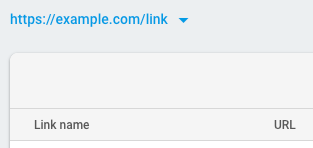You can create short or long Dynamic Links with the Firebase Dynamic Links API. The API takes several optional parameter structures to build links. Short links can also be created from a previously generated long link. The Dynamic Links API will generate a URL like the following:
https://example.page.link/aSDf
Before you begin
Before you can use Firebase Dynamic Links, you need to:
Register your Unity project and configure it to use Firebase.
If your Unity project already uses Firebase, then it's already registered and configured for Firebase.
If you don't have a Unity project, you can download a sample app.
Add the Firebase Unity SDK (specifically,
FirebaseDynamicLinks.unitypackage) to your Unity project.
Note that adding Firebase to your Unity project involves tasks both in the Firebase console and in your open Unity project (for example, you download Firebase config files from the console, then move them into your Unity project).
Set a Dynamic Links URI prefix
In the Firebase console, open the Dynamic Links section.
If you have not already accepted the terms of service and set a URI prefix for your Dynamic Links, do so when prompted.
If you already have a Dynamic Links URI prefix, take note of it. You need to provide a Dynamic Links URI prefix when you programmatically create Dynamic Links.

Recommended: Specify the URL patterns allowed in your deep links and fallback links. By doing so, you prevent unauthorized parties from creating Dynamic Links that redirect from your domain to sites you don't control. See Allow specific URL patterns.
Use the Firebase console
If you want to generate a single Dynamic Link, either for testing purposes, or for your marketing team to easily create a link that can be used in something like a social media post, the simplest way would be to visit the Firebase console and create one manually following the step-by-step form.
Custom domains
You can have greater control over your Dynamic Link's branding by using your own
domain instead of a goo.gl or page.link subdomain. Follow these
instructions to set up a custom domain for
your project.
Using the Firebase Dynamic Links API
Creating a long Dynamic Link from parameters
To create a Dynamic Link, create a DynamicLinkComponents object, setting any
of the optional members for additional configuration, and then access the
LongDynamicLink property to get the link URL.
The following minimal example creates a long Dynamic Link to https://www.example.com/ that opens with your Android app com.example.android on Android and the app com.example.ios on iOS:
var components = new Firebase.DynamicLinks.DynamicLinkComponents( // The base Link. new System.Uri("https://www.example.com/"), // The dynamic link URI prefix. "https://example.page.link") { IOSParameters = new Firebase.DynamicLinks.IOSParameters("com.example.ios"), AndroidParameters = new Firebase.DynamicLinks.AndroidParameters( "com.example.android.package_name"), }; // do something with: components.LongDynamicLink
Creating a short Dynamic Link
To create a short Dynamic Link, pass a previously generated long link to
Firebase.DynamicLinks.GetShortLinkAsync or build DynamicLinkComponents in
the same way as above.
GetShortLinkAsync optionally takes an extra DynamicLinkOptions config
parameter with the PathLength property, allowing you to control how the link
should be generated. Short link generation requires a network request to the
Firebase backend, so the GetShortLinkAsync method is executed asynchronously.
GetShortLinkAsync returns a Task<Firebase.DynamicLinks.ShortDynamicLink>.
For example:
var options = new Firebase.DynamicLinks.DynamicLinkOptions { PathLength = DynamicLinkPathLength.Unguessable }; Firebase.DynamicLinks.DynamicLinks.GetShortLinkAsync(components, options).ContinueWith(task => { if (task.IsCanceled) { Debug.LogError("GetShortLinkAsync was canceled."); return; } if (task.IsFaulted) { Debug.LogError("GetShortLinkAsync encountered an error: " + task.Exception); return; } // Short Link has been created. Firebase.DynamicLinks.ShortDynamicLink link = task.Result; Debug.LogFormat("Generated short link {0}", link.Url); var warnings = new System.Collections.Generic.List<string>(link.Warnings); if (warnings.Count > 0) { // Debug logging for warnings generating the short link. } });
The example above uses a lambda expression that is triggered when the task is completed.
